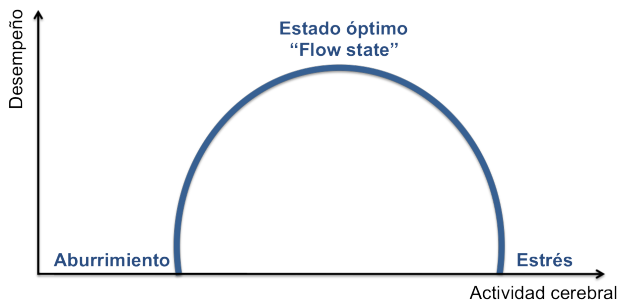Optimal performance state or flow state
The art of leadership is to get people you work with to reach and maintain an optimal performance state. This state is what Daniel Goleman calls in his talk (in the video below) Flow State.
The characteristics of this state are that you have an imperturbable attention (highest level of concentration), you are flexible and adaptable (whatever comes up, you can handle it), your skills are challenged to the highest level and, besides, you feel great. Have you ever felt like that working? Have you ever made someone in your team feel like this entrusting him/her a task?
“An effective and emotionally intelligent leader can help people get and stay in that optimal state for performance, which is also the best internal state possible”.
Daniel Goleman
I think it is something very important to point out once and again that a person performs better when they feel good. This matter is one of the greatest forgotten matters in people management, nowadays when the welfare of people (physical, psychological and emotional) doesn’t occupy or concern the vast majority of managers with dependants, to whom are only entrusted or only have in mind economic or profitability objectives.
Many team managers will reply to what’s been exposed here saying they can’t do anything to make people feel good, that it depends on their personal life and that they have little room for maneuver in this field. Nothing could be further from reality. One of the differences between being a team leader and a functional manager is that, while the first one takes as a responsibility and mission the well-being and growth of the people, the second one only expects operational results leaving emotions parked outside the office.
How do we get our team to reach and maintain that state of optimal performance?
And if we are or want to be leaders, how do we get our team to get and maintain this optimal performance state? Daniel Goleman gives us the keys:
- Setting CLEAR GOALS, being clear about what to do but giving flexibility about how to do it.
- Giving INMEDIATE FEEDBACK helping this way to know how we are doing it and if we are getting closer to the goal.
- Challenging and growing their skill set, giving an assignment that stretches him/her, but always MATCHING THEIR ABILITIES WITH THE TASK YOU GIVE THEM. Because we feel good when we do things we are good at, and normally, we like and enjoy doing that thing we are good at.
These 3 keys are important at the time of getting the team’s brain activity to its optimal state, avoiding from falling into boredom or into stress, being these characterized, among other things, by internal discomfort and void performance.

“As a leader, one of your principal duties is to make people you work with show the best of themselves and make them want to give the best of themselves and, also, make them feel good doing it.”
We mustn’t forget that the state in which people perform at the highest level is also the state in which they feel they are in their best moment.
This is what Daniel Goleman expounds on the first half of the video you can find below and that, the way I see it, it has not even a second to waste. In the second half, Goleman talks about the mirror neurons, scientific explanation of something we already knew, that emotions are contagious.
Besides, people with a more expressive emotional state are able to transfer their state to the rest in only 2 minutes without even talking. This, together with the fact that due to our human nature we tend to pay more attention to the closest person with more authority, emphasizes again the great responsibility there is in the hands of the leader, because he will be capable of transferring his state of mind and attitude to the team in just 2 minutes, influencing the welfare of the people in the team as much as its performance. But if the leader uses this in an intelligent way he will hold in his possession a secret weapon or the 4th key of the art of leading, known as SOCIAL BRAIN, that he might use to get and maintain the team in that optimal state of performance.
The social brain, on the other hand, is no more than an expression of what for me is the leadership core idea: to lead by example, which is applied both for what we say as much as for what we transmit without being aware (through our mirror neurons or our social brain).
Daniel Goleman’s video
And if you liked what you have read, you’ll enjoy this video a lot more.